Interview|Takumi Suzuki
As part of the Hariban Award 2022 programme, we interviewed Takumi Suzuki, CEO of Benrido, Inc. In the interview, Suzuki shares insight on the early beginnings of Benrido’s work with photography and contemporary art using the collotype process and his thoughts on the Hariban Award.
Tell us about your first contact with art and photography in particular. Are there any photographs you have seen that have left a particularly strong impression on you?
As the CEO of Benrido, you have the opportunity to see a variety of photographs, what do you consider photography to be?

Benrido, Inc. CEO Takumi Suzuki inside the Collotype Studio at Benrido Kyoto Head Office © Benrido, Inc.
Today, many photographs can be viewed on digital media, but what do you think is the significance of printing photographs using analogue photographic printing techniques such as collotype?
This is the ninth edition of the Hariban Award, why was the initial impetus for creating the competition in 2014 and what were your thoughts at the time?
TS: About 10 years before we started this award, we began to work with creating contemporary art and photographic works in collotype. We wanted more people to know about and experience the collotype process, so we organised a collotype photography exhibition in New York with the help of prominent photographers and published a portfolio. It would have been nice if we could have continued these activities for a long time, but as it is very expensive to go out into the world and produce publications, we were unable to gain an understanding within the company in terms of cost-effectiveness, so things stagnated for a while after that. However, during that time, my desire to make people around the world aware of the appeal of the collotype did not disappear. It was when I took over as CEO that I put more effort into promoting the collotype technique and studio’s work to the rest of the world. Part of this effort was the Hariban Award.The concept is to invite people to come to our studio in Kyoto, rather than sending our works out from here. I thought that the context of making things in Kyoto with artisans would surely be of interest to others both within and outside of Japan. Thanks to this, many people have applied every year, and we are now in our ninth year.

From left: Takumi Suzuki in the collotype studio with printing assistant Ji-won Lee and Master Printer Osamu Yamamoto © Benrido, Inc.
The Hariban Award is open to everyone who has produced black and white photographic works, whether professional or amateur. Can you tell us what this means?
What do you think is the best part of winning the Hariban Award?
Do you have any advice for people thinking of applying for this year’s Hariban Award?
HARIBAN AWARD 2022 便利堂代表 鈴木巧インタビュー
HARIBAN AWARD 2022プログラムの一環として、アワードを主催する株式会社便利堂代表 鈴木巧にインタビューをおこないました。便利堂がコロタイプを通じて現代アートや写真作品に取り組み始めた頃の話しや、HARIBAN AWARDへの想いについて話をききました。

Benrido, Inc. CEO Takumi Suzuki inside the Collotype Studio at Benrido Kyoto Head Office © Benrido, Inc.
アート、なかでも写真に初めて触れた時のことを教えてください。あるいは、これまで見てきた写真の中で、とくに印象に残っているものはありますか?
便利堂の代表として様々な写真を見る機会があると思いますが、写真とはどのようなものだと考えていますか?
鈴木:芸術作品は、時間と空間、そしてその現実に置かれた自己との関係によって生み出されていくと思いますが、なかでも写真はシャッターを切ることで眼前の唯一無二の時空を切り取ることができるという極めてユニークな手法だと思います。さらに興味深いのは、ただ単に目に見えているものが撮影されるだけでなく、目に見えないものですら写り込み、視覚的にも意味やコンテキスト的にも多層的な奥深さが生まれる余地があるので、一言で写真表現といっても、さまざまな表現の幅があり、ここにコロタイプのようなテクスチャーが加わることでさらに表現の可能性が広がるメディアだと考えています。
現代では多くの写真をデジタル媒体上で見ることができますが、写真をコロタイプという古典写真印画技法でプリントする意味について、どのように考えていますか?
鈴木:仮想世界というのはこれからもますます衰えることなく発展していくでしょう。写真を含むデジタル画像は、その広大な世界への扉となりました。そこでは人類がまだ見たことの無いものが、これから次々と生み出されていくに違いありません。非常に興味深いです。ただ一方で、モノとして実体化したプリントというものは決してなくなりはしないでしょう。それどころか、こうしたデジタル世界が進めば進むほど、モノとしての魅力、特に人の手によるモノ作りに魅力や意味を感じる傾向は強くなるのではないでしょうか。そのモノづくりのひとつにコロタイプがあると思います。そして世界でも希少となったコロタイプによる作品作りは、便利堂でしか体験することができないことでもあります。つまり、コロタイプとの出会いによって、自分自身でもまだ知らない作品を生み出すという可能性がそこにあることも大きな魅力であり、意味だと考えています。

Benrido, Inc. CEO Takumi Suzuki at the Benrido Kyoto Head Office standing next to one of the original printing presses used at Benrido Collotype Atelier. © Benrido, Inc.
今回で9回目を迎えるHARIBAN AWARDですが、2014年にこのコンペディションを立ち上げた理由と、当時の想いを教えてください。
鈴木:このアワードをスタートする10年ぐらい前に、先ほど少し触れたようにコロタイプによる現代アートや写真作品の取り組みに着手しだしました。もっとコロタイプを知ってもらいたい、触れてもらいたいという思いから、著名な写真家たちに協力いただいてコロタイプ写真展をニューヨークで開催したり、ポートフォリオを出版したりしました。これをずっと継続できればよかったのですが、世界に出て行ったり出版物を作ったりすることは非常にお金がかかるので、費用対効果の面で社内の理解を得られず、その後しばらく停滞することになりました。しかし、その間も世界の人々にコロタイプの魅力を知ってほしいという思いは消えませんでした。
そして、私が代表に就任をした機に、あらためて世界にコロタイプをアピールする取り組みを始めました。そのひとつが、このアワードです。こちらから出向くのではなく、京都の工房に来ていただこうというのがコンセプトです。職人と一緒に京都でモノづくりをするという内容は、きっと興味を持っていただけるに違いないと思いました。おかげさまで毎年多くの方々に応募いただき、早いもので9回目を迎えることができました。
HARIBAN AWARDはプロ・アマチュアを問わず、写真作品を制作する全ての人に開かれています。この意味について、お聞かせいただけますか?
鈴木:コロタイプに興味を持ったすべての人が、参加できるようにしたかったからです。著名な審査員による厳正な審査がありますので、もちろん最優秀賞に選ばれることは簡単なことではありませんが、プロかアマか、あるいは有名か無名かにかかわらず、だれにでも等しく参加できる機会を設けることで一人でも多くの方に応募していただきたいと思っています。そしてこの受賞がその人のキャリアと経験のひとつとして貢献できるならば、こんなにうれしいことはありません。

Benrido, Inc. CEO Takumi Suzuki inside the Collotype Studio at Benrido Kyoto Head Office © Benrido, Inc.
HARIBAN AWARDの最優秀賞受賞者には、賞としていくつかの権利が与えられますが、一番の魅力は何でしょうか?
鈴木:やはり日本の伝統を感じていただけるこの京都という地で、職人と一緒になって、まだ見たこともない作品を作り上げるというレジデンスのプロセスではないでしょうか。この2年間はコロナ禍でその実施が停滞していましたが、今回は通常のスタイルに戻ってレジデンスが行えるよう我々も努力したいと思います。
今年のHARIBAN AWARDに応募しようと考えている方々へ、何かアドバイスはありますか?
鈴木:参加を迷っている方は、まずはぜひ応募してみてください。最優秀賞以外にも、審査員賞や奨励賞、便利堂賞などの受賞のチャンスがあります。これら入賞者の作品は公式カタログに収録され、作家にも寄贈されます。素晴らしい作品に出会えるのを楽しみにしています。

